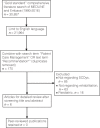Important Clinical Rehabilitation Principles Unique to People with Non-traumatic Spinal Cord Dysfunction
- PMID: 29339906
- PMCID: PMC5667427
- DOI: 10.1310/sci2304-299
Important Clinical Rehabilitation Principles Unique to People with Non-traumatic Spinal Cord Dysfunction
Abstract
Background: Non-traumatic spinal cord dysfunction (SCDys) is caused by a large range of heterogeneous etiologies. Although most aspects of rehabilitation for traumatic spinal cord injury and SCDys are the same, people with SCDys have some unique rehabilitation issues. Purpose: This article presents an overview of important clinical rehabilitation principles unique to SCDys. Methods: Electronic literature search conducted (January 2017) using MEDLINE and Embase (1990-2016) databases for publications regarding SCDys. The focus of the literature search was on identifying publications that present suggestions regarding the clinical rehabilitation of SCDys. Results: The electronic search of MEDLINE and Embase identified no relevant publications, and the publications included were from the authors' libraries. A number of important clinical rehabilitation principles unique to people with SCDys were identified, including classification issues, general rehabilitation issues, etiology-specific issues, and a role for the rehabilitation physician as a diagnostic clinician. The classification issues were regarding the etiology of SCDys and the International Standards for Neurological Classification of Spinal Cord Injury. The general rehabilitation issues were predicting survival, improvement, and rehabilitation outcomes; admission to spinal rehabilitation units, including selection decision issues; participation in rehabilitation; and secondary health conditions. The etiology-specific issues were for SCDys due to spinal cord degeneration, tumors, and infections. Conclusions: Although there are special considerations regarding the rehabilitation of people with SCDys, such as the potential for progression of the underlying condition, functional improvement is typically significant with adequate planning of rehabilitation programs and special attention regarding the clinical condition of patients with SCDys.
Keywords: non-traumatic spinal cord injury; patient care management; rehabilitation; review; spinal cord damage; spinal cord diseases; spinal cord dysfunction; spinal cord injury.
Figures
References
-
- New PW, Marshall R.. International Spinal Cord Injury Data Sets for Non-Traumatic Spinal Cord Injury. Spinal Cord. 2014; 52: 123– 132. - PubMed
-
- New P, Reeves R, Smith É, . et al. International retrospective comparison of inpatient rehabilitation for patients with spinal cord dysfunction epidemiology and clinical outcomes. Arch Phys Med Rehabil. 2015; 96: 1080– 1087. - PubMed
-
- New PW, Cripps RA, Lee BB.. A global map for non-traumatic spinal cord injury epidemiology: Towards a living data repository. Spinal Cord. 2014; 52: 97– 109. - PubMed
-
- Bickenbach J, Boldt I, Brinkhof M, . et al. A global picture of spinal cord injury. : Bickenbach J, Officer A, Shakespeare T, von Groote P, . International Perspectives on Spinal Cord Injury. Geneva: World Health Organization; 2013: 11– 42.
-
- Noonan VK, Fingas M, Farry A, . et al. The incidence and prevalence of SCI in Canada: A national perspective. Neuroepidemiology. 2012; 38: 219– 226. - PubMed
Publication types
MeSH terms
LinkOut - more resources
Full Text Sources
Other Literature Sources
Medical

